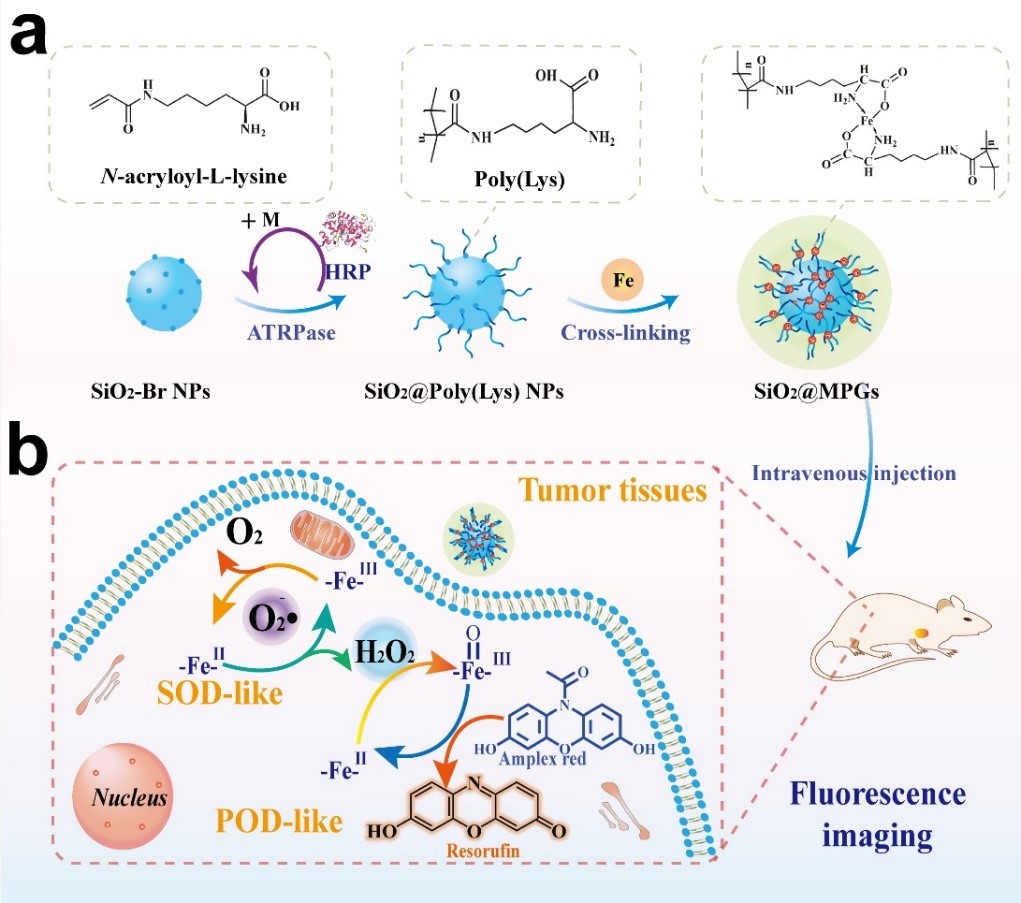"Artificial multienzyme" reported by Wang Qigang's team of Tongji University in Angew Chem Int Edit
Conventional nanozymes, most of which are metal compound nanoparticles, have certain bioactivities mainly due to the catalytic function of transition metal at the compact nanoscale surface. In nature, the binding pocket structure of biological enzymes offering favorable spatial microenvironment near the active center is especially essential for the high catalytic efficiency. Many efforts have been made on the rational design of carbon-based peroxidase mimics by adjusting components and environment of active site to pursue the high activity and selectivity.
Hydrogels as one class of hydrophilic gel with a three-dimensional network structure and good biocompatibility have been applied in many aspects of biomedical fields. And the biomimetic and natural enzymes encapsulated in hydrogel systems have become a hot topic in biological research, due to the protection from structural alterations and subsequent deactivation of the enzymes, ensuring higher loadings and better substrate mobility for efficient catalysis. Hydrogels at nanoscale, namely the nanogels, with both nanosize dimensional stability and the hydrophilic networks as well as fluid-like transport properties can serve as the ideal candidate for further in vivo bio-applications. Despite of the previous excellent work on the macrogel preparation technique, there is still a challenge to realize the modification or assembly in a confined nanospace to obtain the hybrid nanogels.
In view of this, the team of Wang Qigang of Tongji University designed an enzyme-catalyzed atom transfer radical polymerization (ATRPase) and metal coordination cross-linking method to prepare a nano-artificial multi-enzyme gel system successfully from the perspective of bionics. The system had the characteristics of mimetic superoxide dismutase (SOD-like) and peroxidase (POD-like), which can realize the response imaging of cascade catalysis in tumor microenvironment.
The research result was published in the internationally renowned academic journal Angewandte Chemie International Edition under the title of "Multienzyme-Mimic Nanogels Synthesized by Biocatalytic ATRP and Metal Coordination for Bioresponsive Fluorescence Imaging". The School of Chemical Science and Engineering of Tongji University is the only corresponding author unit of the paper. Tongji University Master Qi Meiyuan is the first author. Associate Professor Wang Xia and Professor Wang Qigang of the School of Chemical Science and Engineering are co-corresponding authors.
In this work, an enzyme-catalyzed atomic transfer radical polymerization (ATRPase) method has been proposed and the biocompatible polymer brushes can be obtained by the interfacial polymerization of amino acid (N-acryloyl-L-lysine) monomers. Then the metal coordinated polymeric nanogels (MPGs) have been finally constructed by the coordination effects between amino acid groups and transition metal Fe (II) ions and exhibits efficient multienzyme-like activities (superoxide dismutase (SOD) and peroxidase (POD)) simultaneously (Fig 1). The highly dispersed Fe ions in the gel system can bothe serve as the crosslinking agents for the hydrogel network and as the active centers of mimic enzymes.
By the catalytic activity of SOD-like and POD-like enzymes, the high-level O2− • at the tumor site was catalyzed to generate H2O2, and the safe and efficient tumor imaging was achieved through the cascade enzyme-catalyzed reaction based on the elevated H2O2. The mechanism of this artificial multi-enzyme hydrogel system is similar to the one of natural peroxidase, does not generate hydroxyl radicals showing low toxicity and high biological safety. The facile strategy of biocompatible monomer modification in the confined nanosurfaces by the ATRPase method and metal coordination cross-linking can be applied to further nanoplatform preparation for drug delivery and other biomedical applications.

Figure 1. (a) Preparation process of ATRPase and coordination cross-linking of artificial multi-enzyme nanogel system (b) Fluorescence imaging mechanism of tumor microenvironment response catalyzed by SOD-like and POD-like cascade enzymes
This work was supported by the National Natural Science Foundation of China, National Key Research and Development Program, and the Steady High Magnetic Field Facilities, High Magnetic Field Laboratory, CAS.
Professor Wang Qigang has been working on the researches of enzyme immobilized polymer hydrogel and its biological theranostic for many years. In the past 5 years, more than 50 published SCI papers were published as the correspondence author in Adv.Mater., Nat. Commun., Angew. Chem. Inter. Ed. and other journals.
Literature link: https://www.onlinelibrary.wiley.com/doi/abs/10.1002/anie.202002331
Group website: https://qgwang.tongji.edu.cn/

 Home
>
Content
Home
>
Content